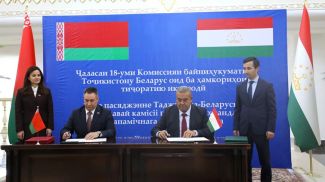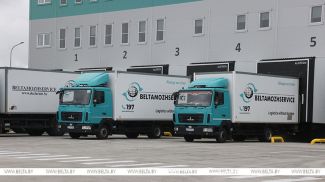BREST, 18 October (BelTA) – The Belarusian economy has entered a phase of recovery growth, Belarusian Economy Minister Aleksandr Chervyakov said at a briefing on ongoing military and political developments in Belarus and abroad for employees of Gefest-Technika company in Brest on 18 October, BelTA has learned.
"After a five-month slowdown, the economy began to grow, starting from August. We expected it, we saw how the situation was developing. Since August the economy has been recovering, including the economy of Brest Oblast. For two months now, the regional economy has been posting good dynamics: the increase was 0.8% in September from August, while the country's economy grew by 0.2%. This is one of the best indicators among the country's regions," the minister said.
Agriculture is the main contributor, he said. Since September, the manufacturing industry has been showing positive dynamics too. "It is important that sectors that produce high-tech goods are beginning to grow. The output of integrated circuits, TV sets, optics, rock haulers, buses, forage harvesters and so on was up by 20%. I am sure that Gefest-Technika is also posting similar results," Aleksandr Chervyakov noted.
He zeroed on in food security, the major concern not only in Belarus but also in the world. Many foreign experts in Europe predict a shortage of food due to their own sanctions. In addition, food prices are rising in the EU. For example, the food basket has become 20% more expensive in the Baltic states. More than 30% of the British have been buying less food products recently.
“The food security issue is not relevant for Belarus, it was solved long ago. We are fully self-sufficient in staple foodstuffs. This year we have harvested a record-high harvest of crops, ensured enough vegetables, and have filled the country's stabilization funds. We continue working on a solid fodder base for livestock. The main conclusion: Belarusians will have enough bread, milk and meat. Our agricultural production volumes allow us to both provide the domestic market and supply world markets. Over the period under review our food exports exceeded $5 billion, up 25% from the previous year,” the minister said.
The transport and logistics industry is also back on recovery track. For example, container rail transportation to China has increased fourfold. “We are working to expand the capabilities of our transport fleet in the markets of Russia, Armenia, Azerbaijan, Turkiye Iran and other countries. We are gradually building new transport and logistics corridors, which contributes to export supplies. The last year's exports almost restored last month: we got a record-high foreign trade surplus of about $3 billion in January-August. This is the best figure for the past 10 years. This surplus provides us with quite a high stability in the economic sector and especially on the currency and financial markets,” said Aleksandr Chervyakov.













